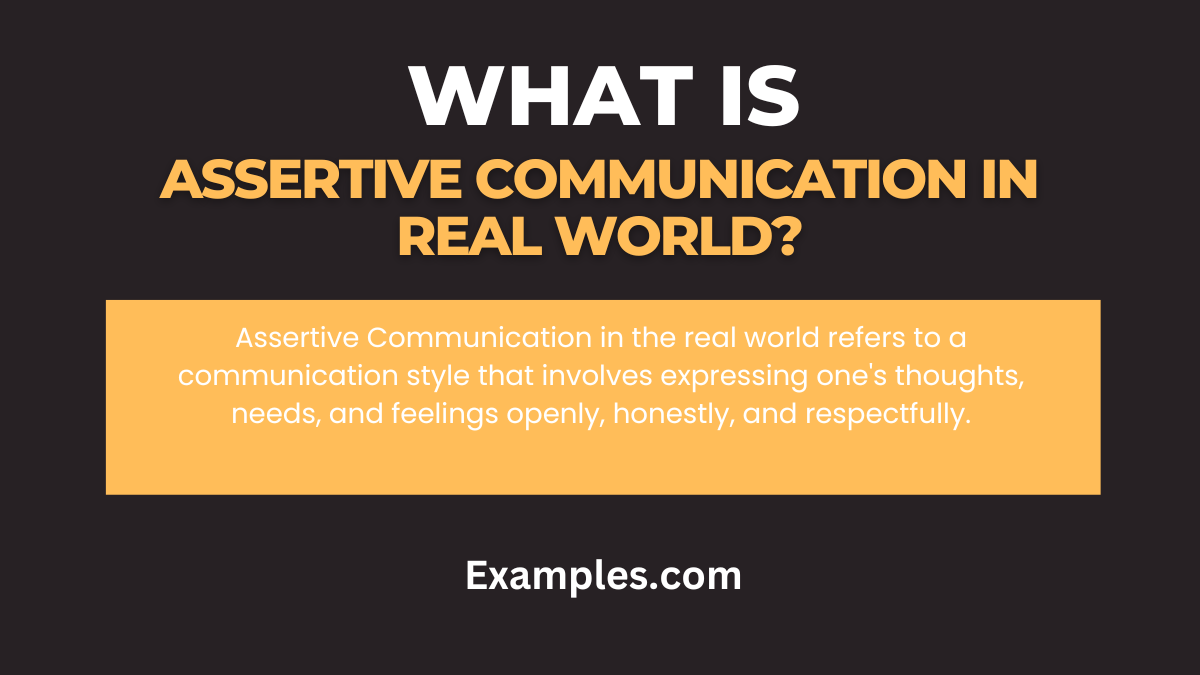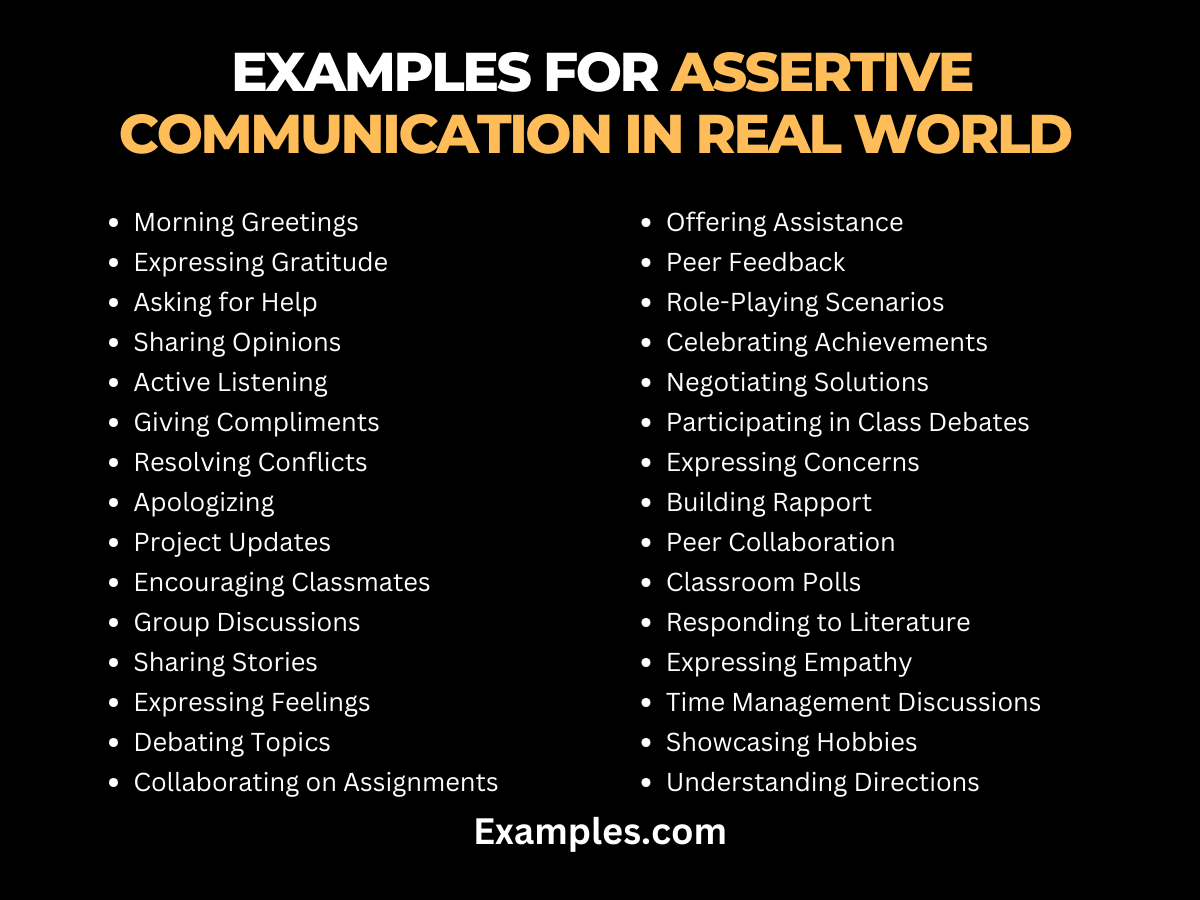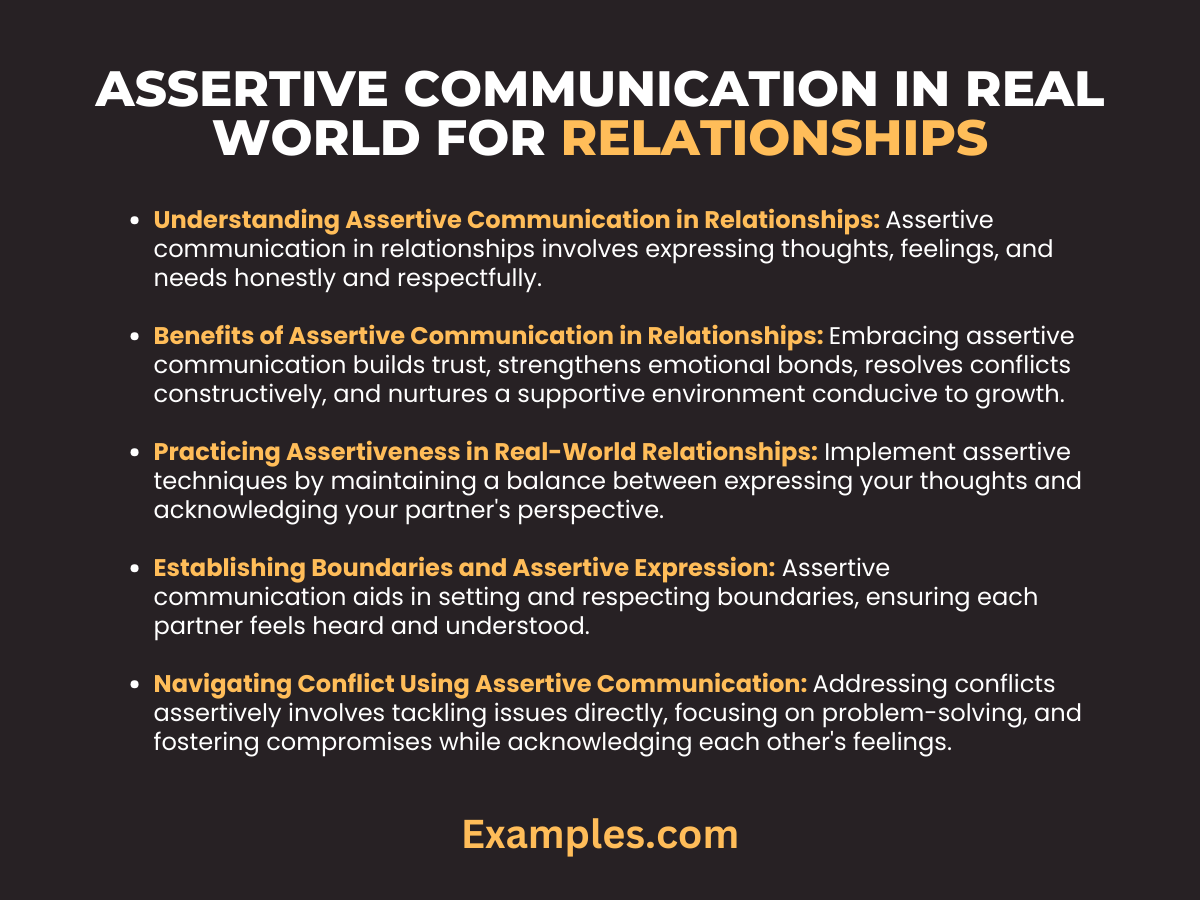29+ Assertive Communication in Real World Examples
Embark on a journey through the intricate tapestry of Communication—unveiling its Definition, tracing its Origin and History, delving into practical How-to insights, and uncovering invaluable Tips. Explore the nuances of effective communication, discover its diverse examples, and enhance your skills for impactful interpersonal connections. From ancient roots to modern applications, this guide is your key to mastering the art of communication in today’s dynamic world.
What is Assertive Communication in Real World?

Assertive Communication in the real world refers to a communication style that involves expressing one’s thoughts, needs, and feelings openly, honestly, and respectfully. It emphasizes standing up for personal rights and boundaries while acknowledging the perspectives of others. In various situations, assertive communication fosters mutual understanding, constructive dialogue, and the establishment of healthy relationships.
30 Examples for Assertive Communication in Real World

Communication is a vital aspect of daily interactions. Mastering diverse ways to express thoughts and connect with others enhances life experiences. From casual conversations to professional dialogues, effective communication enriches relationships and fosters understanding.
- Morning Greetings: Start your day positively by warmly greeting friends, family, or colleagues.
- Expressing Gratitude: Cultivate a habit of thanking others for their contributions and kindness.
- Asking for Help: Politely seek assistance when faced with challenges, fostering collaboration.
- Sharing Opinions: Participate in discussions, expressing your thoughts while respecting diverse viewpoints.
- Active Listening: Demonstrate attentiveness when others speak, fostering understanding and empathy.
- Giving Compliments: Boost positive interactions by offering sincere compliments to friends and colleagues.
- Resolving Conflicts: Navigate disagreements diplomatically, promoting harmony and understanding.
- Apologizing: Acknowledge mistakes with a sincere apology, fostering accountability and growth.
- Project Updates: Keep team members informed by providing regular updates on ongoing projects.
- Encouraging Classmates: Offer support and encouragement to classmates facing challenges in academic settings.
- Group Discussions: Engage actively in group projects, ensuring everyone’s input is valued.
- Sharing Stories: Promote effective storytelling skills by sharing interesting anecdotes during conversations.
- Expressing Feelings: Confidently share emotions when discussing personal experiences or favorite subjects.
- Debating Topics: Enhance critical thinking by participating in friendly debates on various subjects.
- Collaborating on Assignments: Showcase teamwork by working collaboratively on academic assignments.
- Offering Assistance: Volunteer to help classmates or colleagues with their tasks, fostering mutual support.
- Peer Feedback: Provide constructive feedback to peers during presentations, encouraging improvement.
- Role-Playing Scenarios: Develop adaptability and problem-solving skills through communication role-playing.
- Celebrating Achievements: Reinforce positive communication habits by celebrating personal and collective accomplishments.
- Negotiating Solutions: Hone negotiation skills by seeking compromises during group activities.
- Participating in Class Debates: Sharpen critical thinking through active involvement in classroom debates.
- Expressing Concerns: Foster open dialogue by confidently communicating concerns with teachers or colleagues.
- Building Rapport: Create a friendly and inclusive environment by initiating conversations to build rapport.
- Peer Collaboration: Develop teamwork and communication proficiency by collaborating with peers on projects.
- Classroom Polls: Engage in democratic decision-making by participating in classroom polls and expressing opinions.
- Responding to Literature: Cultivate analytical and expressive communication by articulating responses to literature.
- Expressing Empathy: Demonstrate empathy by understanding and supporting classmates’ experiences.
- Time Management Discussions: Emphasize the importance of clear communication in planning by engaging in time management discussions.
- Showcasing Hobbies: Foster shared experiences by presenting personal hobbies and interests to classmates.
- Understanding Directions: Demonstrate the ability to understand and follow directions in various academic and social contexts.
Assertive Communication in Teaching Kids for the Real World
Effective communication skills are crucial life tools, and teaching them to kids lays a strong foundation for their future interactions. Assertive communication, a key aspect, empowers children to express themselves clearly, build self-esteem, and navigate real-world scenarios confidently. Here’s a comprehensive guide on fostering assertive communication skills in kids:
Creating Safe Environments: Foster an environment where children feel secure expressing themselves without fear of judgment or repercussions.
Teaching Respectful Communication: Guide kids on how to voice their thoughts respectfully while valuing others’ opinions and feelings.
Encouraging Open Dialogue: Promote open communication by initiating discussions on various topics, welcoming questions, and listening actively.
Role-Playing Scenarios: Engage children in role-playing exercises to simulate real-life situations, encouraging them to respond assertively.
Demonstrating Through Modeling: Lead by example—display assertive behavior in your interactions with kids and others.
Emphasizing Self-Worth: Instill confidence in children by highlighting their worth and encouraging them to communicate their needs.
Teaching Assertive Language: Equip children with assertive language and phrases to articulate their feelings and requests respectfully.
Managing Emotions: Teach kids to manage their emotions effectively by expressing them appropriately without resorting to aggression or withdrawal.
Assertive Communication in Real World for Relationships
Assertive communication in relationships is crucial for fostering mutual understanding, respect, and healthy interactions. Employing assertive techniques positively influences relationship dynamics, allowing individuals to express their thoughts, needs, and boundaries effectively. Here’s a comprehensive guide to applying assertive communication in real-world relationships:

Understanding Assertive Communication in Relationships: Assertive communication in relationships involves expressing thoughts, feelings, and needs honestly and respectfully. It emphasizes open dialogue, active listening, and mutual respect, fostering healthier connections.
Benefits of Assertive Communication in Relationships: Embracing assertive communication builds trust, strengthens emotional bonds, resolves conflicts constructively, and nurtures a supportive environment conducive to growth.
Practicing Assertiveness in Real-World Relationships: Implement assertive techniques by maintaining a balance between expressing your thoughts and acknowledging your partner’s perspective. Employ ‘I’ statements, active listening, and empathetic responses.
Establishing Boundaries and Assertive Expression: Assertive communication aids in setting and respecting boundaries, ensuring each partner feels heard and understood. It enables both individuals to express needs without guilt or aggression.
Navigating Conflict Using Assertive Communication: Addressing conflicts assertively involves tackling issues directly, focusing on problem-solving, and fostering compromises while acknowledging each other’s feelings.
Strengthening Intimacy Through Assertive Communication: Open and respectful communication enhances emotional intimacy, allowing partners to share vulnerabilities, desires, and aspirations, fostering a deeper connection.
Building Trust and Respect: Consistent practice of assertive communication breeds trust and respect, essential pillars for a healthy and lasting relationship. It encourages authenticity and reduces misunderstandings.
Challenges and Overcoming Barriers: Recognize challenges like fear of confrontation, societal conditioning, or past communication patterns, and work on overcoming these barriers to implement assertiveness effectively.
Assertive Communication in the Real World: A Student’s
Mastering assertive communication is a crucial skill for students, influencing academic success and personal growth. This comprehensive guide explores the dynamics of assertive communication in real-world student scenarios, providing practical insights, techniques, and examples.
1. Understanding Assertive Communication: Embrace the essence of assertive communication—expressing thoughts and needs confidently while respecting others. Learn how assertiveness differs from aggression or passivity.
2. Importance in Academic Settings: Discover the impact of assertive communication on student life, academic performance, and effective collaboration in group projects and discussions.
3. Navigating Classroom Interactions: Explore assertive communication strategies to actively participate in class, ask questions, share opinions, and engage in healthy debates.
4. Assertive Communication in Group Projects: Uncover techniques for asserting your ideas, resolving conflicts, and contributing meaningfully to group projects without dominating or withdrawing.
5. Handling Peer Relationships: Navigate the complexities of peer interactions with assertive communication, fostering positive relationships and addressing challenges confidently.
6. Communicating with Teachers: Develop effective communication skills to express concerns, seek clarification, and build a respectful rapport with teachers for an optimal learning experience.
7. Assertiveness in Extracurricular Activities: Apply assertive communication in extracurricular pursuits, from club meetings to sports teams, enhancing leadership skills and teamwork.
What are Characteristics of Assertive Communication in the Real World?
Assertive communication in the real world embodies clarity, respect, empathy, and directness. It involves active listening, setting boundaries, and fostering open, honest expression for effective interpersonal interactions.
- Clear Expression: Assertive communicators convey thoughts with clarity and precision.
- Respectful Tone: Maintaining a tone of respect fosters positive interactions.
- Empathy: Understanding others’ perspectives is a key aspect of assertive communication.
- Body Language: Non-verbal cues complement assertive expression for effective communication.
- Conflict Resolution: Assertive communicators navigate conflicts with strategies promoting amicable solutions.
- Emotional Control: Maintaining composure enhances the effectiveness of assertive communication.
- Constructive Feedback: Offering and receiving feedback constructively contributes to personal and collective growth.
- Setting Boundaries: Assertive individuals establish and communicate clear personal boundaries.
- Adaptability: Adjusting communication style in different situations reflects assertive flexibility.
- Collaboration: Embracing teamwork encourages collective achievement in assertive communication.
In wrapping up the exploration of Assertive Communication in the Real World, it’s clear that this communication style is not just a skill but a pathway to more fulfilling and effective interactions in various aspects of life. Assertive communication empowers individuals to express themselves openly and respectfully, fostering healthy relationships and promoting mutual understanding. Whether it’s in personal connections, academic environments, or professional settings, assertive communication plays a crucial role in enhancing dialogue and building strong, respectful relationships.
To deepen your understanding and practice of assertive communication, consider exploring the University of Minnesota’s resource on Assertive Communication, which offers insightful tips and techniques to enhance your communication style here. Additionally, North Dakota State University provides valuable insights on Assertiveness Skills, helping you navigate real-world scenarios with confidence and clarity here. These external resources serve as excellent supplements to further enhance your assertive communication skills, providing practical guidance and strategies that are beneficial for both personal and professional growth.



